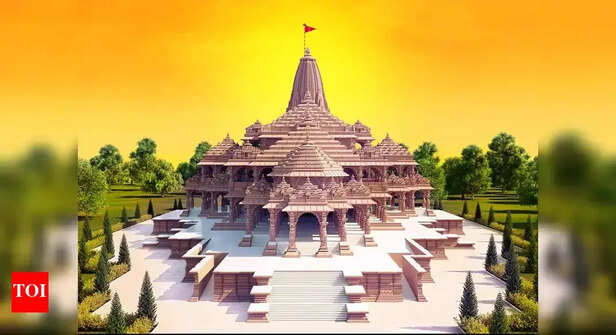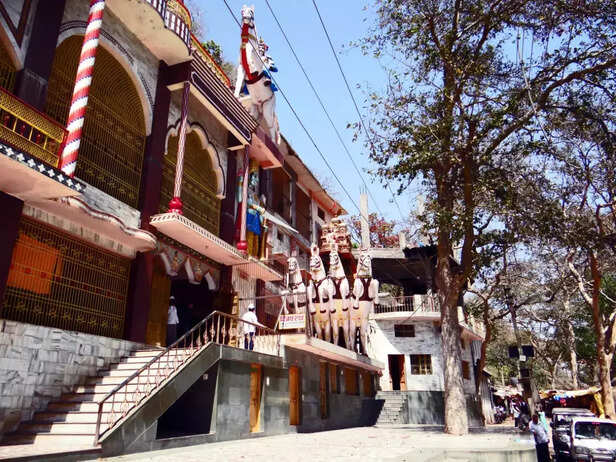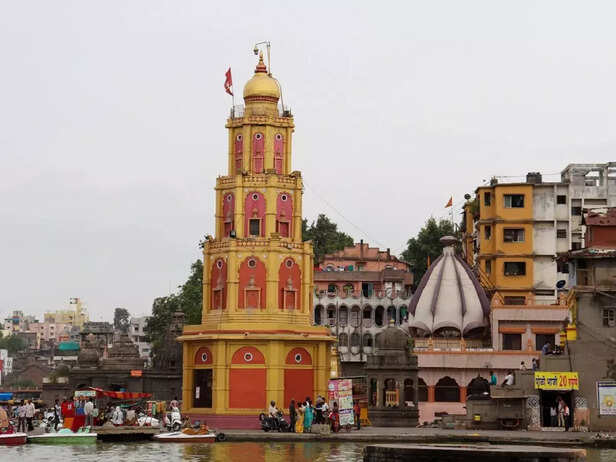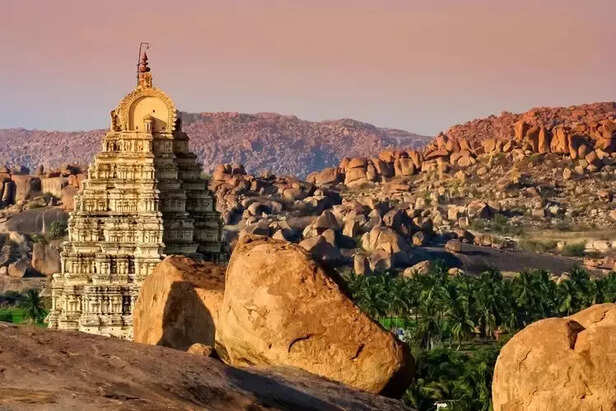5 Places from the Ramayana You Can Still Visit Today
Riya Kumari | Apr 25, 2025, 23:53 IST

( Image credit : Times Life Bureau )
Okay, hear me out. You know that moment in a Hollywood romcom when the protagonist decides to go on a spontaneous trip to find herself—and ends up sipping wine in Tuscany or falling in love at a bookstore in Notting Hill? Yeah, this is kinda like that. Except the wine is probably chai, the romance is mostly with the architecture, and the bookstore is... an ancient temple where a demon once got his butt handed to him.
There’s a strange kind of magic in walking the same earth as legends. We scroll through mythologies like we scroll through social media—looking for the highlight reel, the action, the metaphors that make us feel wise for quoting them. But what if, instead of just reading the Ramayana, you could stand in it? Feel the wind that once whispered through its pages. Sit where exile felt less like punishment and more like the beginning of something bigger than comfort. Because here’s the truth most people miss: the Ramayana isn’t just about gods and demons. It’s about choices. About dignity. About what it means to carry your dharma—not because the world applauds you for it, but because it's the only thing that keeps you from breaking.
1. Ayodhya

Where dharma was born—and then tested. Ayodhya is more than a place. It's a question that still hangs in the air: What are you willing to give up for the truth you believe in? This is where Rama, the prince, walked away from a throne to honor a promise he didn’t even make. Not for glory. Not for sympathy. Just because it was right.
When you walk through the ghats, through the temples, through the bustling debates of modern-day Ayodhya, you realize: the city hasn’t changed as much as we think. It's still asking us—What would you do if your comfort came at the cost of someone else’s word? We all want to be right. But Ayodhya reminds us—sometimes, being righteous is quieter, lonelier, and infinitely harder.
2. Chitrakoot

Where simplicity became sacred. Chitrakoot is where Rama, Sita, and Lakshman went not to escape—but to begin. This is where they let go of palaces and politics and chose something deeper: a life rooted in nature, in silence, in stillness. It’s easy to romanticize the forest life. But when you’re there—among the rustling leaves and ancient hills—you start to feel it. The ache of letting go. The peace that slowly grows in its place.
There’s wisdom here that modern life forgets: not everything that is smaller is lesser. And not everything that is quiet is weak. Chitrakoot teaches us that exile is not always punishment. Sometimes, it's preparation.
3. Panchavati

Where boundaries were drawn—and broken. We talk a lot about drawing lines. Personal boundaries. Moral lines. What we’ll tolerate, and what we won’t. But in Panchavati, that line was literal. Lakshman drew it to protect Sita. Ravana crossed it with deceit. And the world changed forever.
Standing at Sita Gufa, you realize: sometimes the lines we draw come from love—but the world doesn’t always honor them. And sometimes, protection becomes confinement. Sometimes, a line is a prison in disguise. Panchavati doesn’t just remind us of a kidnapping—it reminds us that even in stories thousands of years old, women are still being asked to stay inside circles drawn by others.
4. Kishkindha

Where unlikely allies changed everything. This is where Rama met Hanuman. Where a divine prince joined hands with a monkey king, not because of blood or title—but because purpose bound them together. In a world obsessed with pedigree, Kishkindha teaches something radical: character matters more than caste. Integrity can come in any form—even with a tail and a roar.
Hampi’s boulders still echo with that energy. That sacred chaos. That sense that the world shifts when courage and loyalty come together. We spend so much time choosing our people based on status. Kishkindha reminds us: choose the ones who believe in your mission—even when they don’t look like they belong in your story.
5. Rameswaram

Where the impossible was made real. A bridge across the ocean. Built by beings the world called “lesser.” With stones that floated not because of science, but because of belief. Rameswaram is a monument to faith—not the blind kind, but the kind that moves you to act. It’s where grief turned into resolve. Where loss didn’t break Rama—it built him.
Today, the sea still laps gently at Dhanushkodi. And if you stand long enough, you can almost feel it: the stillness before a storm. The calm before the leap. The hush before transformation. Rameswaram doesn’t shout. It doesn’t need to. It’s the quiet power of doing what must be done—even when you’re tired. Especially when you’re tired.
Closing Thoughts:
The Ramayana isn’t asking us to worship. It’s inviting us to witness. To walk the earth and feel what it means to lose what you love, and still choose honor. To live in a time where shortcuts are easy, and still walk the long road anyway. To face questions that have no easy answers—and still show up.
These places don’t just preserve history. They confront us with it. Not in stone, but in story. Not in rituals, but in reflection. So go. Not just to take photos. Go to remember that the divine didn’t just live here once—it’s still living in the choices we make every single day. The Ramayana isn’t over. We’re all still writing it.
1. Ayodhya

Ayodhya
( Image credit : Times Life Bureau )
Where dharma was born—and then tested. Ayodhya is more than a place. It's a question that still hangs in the air: What are you willing to give up for the truth you believe in? This is where Rama, the prince, walked away from a throne to honor a promise he didn’t even make. Not for glory. Not for sympathy. Just because it was right.
When you walk through the ghats, through the temples, through the bustling debates of modern-day Ayodhya, you realize: the city hasn’t changed as much as we think. It's still asking us—What would you do if your comfort came at the cost of someone else’s word? We all want to be right. But Ayodhya reminds us—sometimes, being righteous is quieter, lonelier, and infinitely harder.
2. Chitrakoot

Chitrakoot
( Image credit : Times Life Bureau )
Where simplicity became sacred. Chitrakoot is where Rama, Sita, and Lakshman went not to escape—but to begin. This is where they let go of palaces and politics and chose something deeper: a life rooted in nature, in silence, in stillness. It’s easy to romanticize the forest life. But when you’re there—among the rustling leaves and ancient hills—you start to feel it. The ache of letting go. The peace that slowly grows in its place.
There’s wisdom here that modern life forgets: not everything that is smaller is lesser. And not everything that is quiet is weak. Chitrakoot teaches us that exile is not always punishment. Sometimes, it's preparation.
3. Panchavati

Panchavati
( Image credit : Times Life Bureau )
Where boundaries were drawn—and broken. We talk a lot about drawing lines. Personal boundaries. Moral lines. What we’ll tolerate, and what we won’t. But in Panchavati, that line was literal. Lakshman drew it to protect Sita. Ravana crossed it with deceit. And the world changed forever.
Standing at Sita Gufa, you realize: sometimes the lines we draw come from love—but the world doesn’t always honor them. And sometimes, protection becomes confinement. Sometimes, a line is a prison in disguise. Panchavati doesn’t just remind us of a kidnapping—it reminds us that even in stories thousands of years old, women are still being asked to stay inside circles drawn by others.
4. Kishkindha

Hampi
( Image credit : Times Life Bureau )
Where unlikely allies changed everything. This is where Rama met Hanuman. Where a divine prince joined hands with a monkey king, not because of blood or title—but because purpose bound them together. In a world obsessed with pedigree, Kishkindha teaches something radical: character matters more than caste. Integrity can come in any form—even with a tail and a roar.
Hampi’s boulders still echo with that energy. That sacred chaos. That sense that the world shifts when courage and loyalty come together. We spend so much time choosing our people based on status. Kishkindha reminds us: choose the ones who believe in your mission—even when they don’t look like they belong in your story.
5. Rameswaram

Ram Setu
( Image credit : Times Life Bureau )
Where the impossible was made real. A bridge across the ocean. Built by beings the world called “lesser.” With stones that floated not because of science, but because of belief. Rameswaram is a monument to faith—not the blind kind, but the kind that moves you to act. It’s where grief turned into resolve. Where loss didn’t break Rama—it built him.
Today, the sea still laps gently at Dhanushkodi. And if you stand long enough, you can almost feel it: the stillness before a storm. The calm before the leap. The hush before transformation. Rameswaram doesn’t shout. It doesn’t need to. It’s the quiet power of doing what must be done—even when you’re tired. Especially when you’re tired.
Closing Thoughts:
These places don’t just preserve history. They confront us with it. Not in stone, but in story. Not in rituals, but in reflection. So go. Not just to take photos. Go to remember that the divine didn’t just live here once—it’s still living in the choices we make every single day. The Ramayana isn’t over. We’re all still writing it.
